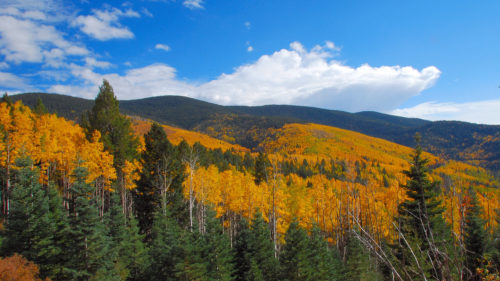A few years back, after my son’s fall elk hunt, I ran into the game warden here in town (Silver City). He included in his range of responsibility Unit 15 south of Quemado, and had given us a tip or two on where to camp and look for elk. Now with our hunt over, he was curious how we’d done.
I told him his advice was good, that on the last day son Buddy had shot a cow elk in a remote canyon and that with help we managed to bone it out and pack it two miles to camp. I also mentioned that on a scouting trip a few weeks earlier we’d had a good hunt in the same area for native tassel-eared squirrels (abert’s squirrel).
“You went squirrel hunting?” He remarked. “I think I’ve only checked one set of squirrel hunters in my six years in that section.”
“There seemed to be quite a few squirrels in that unit,” I said. “We only got four but there were others we passed up and some got away.”
“Oh, I always see squirrels,” he said, “but nobody hunts them.”
Well, almost nobody. Our southwestern tree squirrels are, in that overworked term of the outdoor writer, “under-utilized.” Yet these colorful, two pound acrobats of the pines offer many attributes as game. Take a weekend a few years back when Bud and I made another hunt for squirrels in the mountains south of Quemado.
The woods were crawling with elk hunters. Actually it was more the forest roads; once we got back into the woods we didn’t see anybody. Of course an elk hunt is a bigger deal than a squirrel hunt but to go for elk you have to get drawn and your odds on most hunts are well under 50 percent. Then if you do draw a permit your odds of getting an elk are again well under 50 percent. Your season is less than a week long, the elk tag is expensive, and many locales will be crowded with fellow elk hunters.
As squirrel hunters our license is cheap, can be bought over the counter or on line, and the season in New Mexico is three months long. The limit is eight squirrels per day and we seldom get skunked. Competition from other squirrel hunters is minimal and, perhaps best of all, you can hunt them with a dog.
Of course, you can hunt them without a dog, too. That’s the way I started hunting them when I moved to Catron County in 1980. I’d spot a squirrel out on the ground feeding early in the morning; he’d invariably be on the run before I could get a shot with my .22 magnum. So I’d run after him, hoping to force the squirrel to tree before he got out of sight.
Sometimes this worked but it’s foolhardy to run with a gun through the woods. And I had a companion at the time with a trim, smart, prick-eared mongrel. One day a light came on and I thought, “What about Toccoa?”
My friend liked to hunt and was eager to try her dog, who was “just a pet,” on squirrels. Toccoa took after that first squirrel and she put him up a tree in half the distance I could have managed it; even more importantly, I didn’t fall on the run and shoot myself.
Once he was up in a big ponderosa, Toccoa marked the tree and learned to keep her eye on the squirrel. She never really learned to use her nose in squirrel hunting but with her legs and good eye she was very useful and made the hunt more interesting.
Alas, for reasons outside this story, both the companion and the companion’s dog were there for only two seasons of squirrel hunting. Since, my son Bud has been the perfect squirrel hunting companion as he has grown up. But that still leaves us missing the dog. I’ve tried greyhound, coonhound, and a couple of Jack Russell terriers. All had their talents and liked hunting squirrels but none was as effective as Toccoa. But now we have “Jack.”
Jack is a mostly Jack Russell terrier but too big to be a purebred specimen of the breed. We got him to be a companion to Buddy growing up – “just a pet” you might say. That’s a noble calling by itself and Jack and Buddy have shared many adventures. But a few years ago, when ground squirrels invaded the barn, Jack showed he had some hunting instincts as well. It’s an on-going battle with those incessant diggers and grain feeders but Jack has caught and killed a half-dozen that I know of. I said to Buddy, “Jack may be our squirrel dog!”
Jack got the hang of it right away to push those on the ground up a tree. And he would “locate” on the tree. He was a bit gun-shy, however. So, after he treed a squirrel, I took to holding him while Bud did the shooting; the extra security seemed to work as he barely flinched at the shot and was on those squirrels as they hit the ground. And he proved he could locate a squirrel by scent; i.e. one that already treed – a “lay-up” squirrel.
One squirrel treed ahead of us but we never saw him. Jack trailed him a hundred yards or so, sniffed the trunk of a certain Ponderosa, circled the pine a time or two, jumped up and sniffed the bark, and as much as told us in plain English, “He went up this one, guys.” We circled the pine and looked up and Jack was right.
No, we didn’t come home with a lot of squirrels, But we got that one and some others and it would have been maybe half that without Jack. And, as always, it was a better hunt with a good dog.
Squirrel Posole: Any good pozole recipe will work; you just substitute squirrel meat for the traditional pork. The trick is the preparation of the meat before it’s cooked. Gut the squirrel in the field and keep the meat cool till you get home. Bone out the squirrel, cut away any bloodshot meat, and cut into pieces. Soak it overnight in your favorite marinade (simple tomato juice works for me) and it will take the “game” out of the meat. Then add in the hominy, onions, and the rest of the posole recipe and simmer long and slow.



